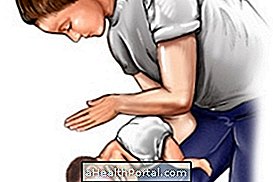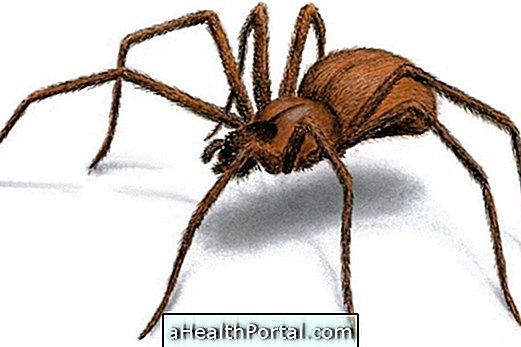The Heimlich maneuver is a first aid technique used in cases of emergency by suffocation, caused by a piece of food or any foreign body that is trapped in the respiratory tract, preventing the person from breathing.
In this maneuver, the hands are used to press on the diaphragm of the choked person, which causes a forced cough, that causes that the object is expelled from the lungs. It was invented by the American physician Henry Heimlich in 1974 and can be practiced by anyone, if you follow the guidelines correctly:

See the possible causes when the person chokes often.
What to do before the maneuver
After detecting that the person can not breathe properly due to a choking, the first step is to ask him to cough hard and then apply 5 dry strokes on the back with the base of one hand. If this is not enough, one should prepare to apply the Heimilich maneuver, which can be done in 3 ways:
1. In the agreed upon person

This is the traditional Heimlich maneuver, being the main way to perform the technique. The step-by-step consists of:
- Position yourself behind the victim, wrapping her arms around her;
- Close one hand, with the well closed wrist and the thumb above, and position it in the superior region of the abdomen, between the navel and the rib cage;
- Place the other hand on the closed fist, grasping it firmly;
- Pull both hands inward and upward . If this region is difficult to access, as it may happen in obese or pregnant women in the last weeks, one option is to locate the hands on the thorax;
- Repeat the maneuver for up to 5 consecutive times, observing if the object has been expelled and if the victim breathes.
Most of the time, these steps are sufficient for the object to be expelled, however, in some cases, the victim may continue to be unable to breathe properly and eventually faint. In this case, the maneuver should be made adapted to the person who is unconscious.
2. In the person who fainted

When the person is unconscious or fainting, the Heimlich maneuver is made by denting the victim on a hard flat surface, and then must:
- Sit facing the victim, over your basin or legs;
- Place open hands, one over the other in the upper abdomen, near the chest;
- Make strong pressure inward and upward using body weight, and repeat as many times as necessary.
During the maneuver, it is important to note if the victim is still breathing. If a respiratory arrest occurs, it is necessary to stop this maneuver and start cardiorespiratory resuscitation, with cardiac massage and mouth-to-mouth respiration. Learn the steps of what to do in case of cardiorespiratory arrest.
3. In the person himself

It is possible for a person to choke on his own, and if that happens, it is possible to apply Heimlich's maneuver on yourself. In this case, the maneuver should be done as follows:
- Close the wrist of the dominant hand and place it in the upper part of the abdomen, between the navel and the end of the rib cage;
- Hold this hand with a non-dominant hand, achieving better support;
- Push hard, quickly, both hands in and up.
Repeat the movement as many times as necessary, but if it is not effective, the maneuver should be made with more force, using the support of a firm and stable object that reaches the waist region, such as a chair or a counter. Thus, with the hands still on the abdomen, one must push the body with force against the object.
What you want to do in case of a choked baby

If the baby suffers a serious choking with an object or food that prevents him from breathing, the maneuver is done differently. The first step is to place the child on the arm with the head slightly lower than the trunk and observe if there is any object in his mouth that can be removed.
Otherwise, and she will continue to choke, she should lean her, with her belly on her arm, with her lower torso lower than her legs, and tap her with the base of her hand on her back. If this is still not enough, the child should be turned over, still on the arm, and make compressions with the middle and ring fingers on the child's chest in the region between the nipples.
To learn more details on how to disengage your baby, check out what to do if your baby chokes.

























